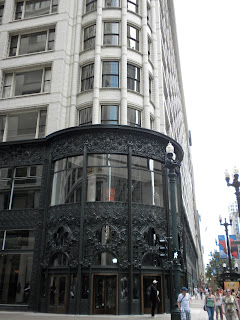Louis Sullivan is a luminary in the field of architecture, not just Chicago architecture. He is considered to be the father of modern architecture, as he was one of the first architects to draw inspiration from within rather than historical sources. Prior to that time, much architecture consisted of revival movements of previous styles -- Greek Revival, Gothic Revival, Neoclassical, or Italianate (a rehashing of Renaissance motifs) to name a few. Sullivan embraced the new technology of steel-frames to create buildings of ever-increasing height, and was instrumental in the creation of the modern skyscraper.
Sullivan, who originally hailed from Massachusetts, relocated to Chicago in 1873 to capitalize on the explosion in building work that resulted from the Great Chicago Fire in 1871 which destroyed four square miles in the heart of the city. The photo above shows the extent of the devastation.
Although Sullivan, also a noted theorist and critic in the field of architecture, coined the term, "Form follows function," which was later interpreted to mean that buildings should be stripped of ornament beyond essential structural function, Sullivan's style was notable for his intensive use of Art Nouveau, botanical, and geometric motifs. Instead of stone, he clad his buildings in the lighter terra cotta and cast iron, which he favored not only for their practicality but for their greater malleability in creating elaborate patterns.
My favorite story from the exhibition was related to the photo above, which shows a pedestrian walkway connecting the Carson Pirie Scott department store directly to the El station at Madison and Wabash. The builders had not obtained city permission to construct the walkway, instead erecting one night under the cover of darkness. The next day, city officials were outraged, but the store was ultimately allowed to maintain the structure. It no longer exists today, but the story reminded me of a tactic favored by our current mayor, Richard M. Daley, who bulldozed the runways at Meigs Field, a private airport on the city's lakefront, in the middle of the night in 2003 to allegedly protect the city from the threat of terrorism. No matter that the Mayor had been trying to close the airport in the face of pressure from influential aviation groups since 1994...
Although the exhibit consisted mainly of photographs, architectural drawings, and building fragments, it was surprisingly compelling. My only complaint was the utilization of space in the galleries. In order to convey maximum detail, the exhibit utilized monumental over-sized photos that stretched from above the normal eyeline to within a foot or so of the floor. Often, the labels for these photos were located underneath them, so low to the ground that the audience practically had to sit on the floor to read them. I'm not sure what the exhibition designers were thinking there -- it would have been much more user-friendly if the labels had been located at eye level next to the photos, not below them.
After we finished at the Cultural Center, I decided to take advantage of the relatively tolerable temperatures in the shade and walk the mile and half back to my apartment. I opted to give myself a tour of some of the few remaining Sullivan buildings in the city. First, I passed by the Carson Pirie Scott Building, which is protected by its place on the U.S. Register of Historic Places. Dating back to 1899, the ornate cast iron facade on the building's ground floor was ostensibly functional -- it was hoped it would attract customers and draw them through the door.
My other visit was to the Auditorium Building, built by the firm of Adler & Sullivan in 1889. Uncharacteristically, it employs a hulking load-bearing exterior instead of the steel frame usually employed by Sullivan. At the time of its construction, it was the tallest building in the city of Chicago, and the largest building in the entire country. Hyperbolic accounts from early visitors alleged that people could see Iowa from the top of the structure. Originally, the building housed a hotel, offices, and the Lyric Opera company, which moved to its own facility at the Civic Opera House in 1929, causing the theater portion of the building to close during the Great Depression. Roosevelt University moved into the structure in 1947 after it was founded to educate returning G.I.s from World War II. The theater was reopened in the 1960s, but was not restored to its original finishes until 2001.
I was glad that Irene invited me out to see the Sullivan exhibit, as it forced me to look at the city with fresh eyes. So often we go about our daily lives and take for granted the history and beauty that surrounds us, but it is always good to be reminded to take the time to stop and appreciate it all.
I was glad that Irene invited me out to see the Sullivan exhibit, as it forced me to look at the city with fresh eyes. So often we go about our daily lives and take for granted the history and beauty that surrounds us, but it is always good to be reminded to take the time to stop and appreciate it all.







No comments:
Post a Comment